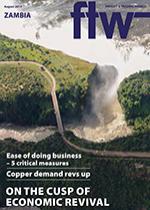Demand for electric vehicles is expected to push demand for copper past supply by the year 2020 – which is good news for everyone involved in mining copper and moving chemical inputs and the semiprocessed outputs in the Copperbelt.
A growing number of countries have said they will phase out internal combustion engines over the next 10 to 15 years. This will create physical demand for copper. A standard internal combustion-engined car contains around 25 kilograms of copper.
This goes up to 50 kg for a hybrid vehicle and 74 kg for a full electric vehicle. The battery alone in an electric car contains about 38 kilograms of copper, 11 kilograms of cobalt and 11 kilograms of nickel. A strong and sustained copper price is essential for the Zambian economy.
Mining accounts for 12% of Zambia´s GDP and 70% of total export value, according to World Bank estimates. Low copper prices have had farreaching effects on the Zambian economy – and along with it the logistics companies which have had to cut rates and increase the range of services offered to clients just to stay in business.
The ripples are felt throughout the Zambian economy. According to Nielsen, Zambian retailers have reported a deterioration in the ease of doing business and a sharp fall in consumer spending over the past two years. This is confirmed by forwarders and truckers interviewed by FTW who said that their volumes of fast moving consumer goods had dropped markedly. Copper is not the only bright spot on the Zambian horizon, however.
A focus by government on the agricultural sector is, literally, bearing fruit. Zambia’s total land area is 75 million hectares (752000 Km2), 58% (42 million hectares) of which is classified as medium to high potential for agricultural production, with rainfall ranging between 800 mm and 1 400 mm a year. Major crops are maize, millet and wheat, with export potential for maize and millet in particular.
According to the department of agriculture the production of crops like millet, ground nuts, mixed beans, burley tobacco, sorghum, soya, seed cotton, sweet potatoes and wheat has recovered following the end of the devastating drought.
There are also signs that government efforts to stimulate manufacturing are starting to have an effect. Logistics companies interviewed by FTW report handling increasing quantities of machinery for both greenfields operations and expansion of existing factories.
At present growth is largely driven by the agro processing, textile and leather subsectors, according to the Zambia Development Agency.
There is also a growing lobby for the Zambian government and mining sector to buy local. The government has responded by regularly and without much warning introducing and then lifting import and export bans on agricultural staples.
With regulations changing constantly, importers and exporters need to ensure they are fully compliant before shipping their freight.
.PNG)

